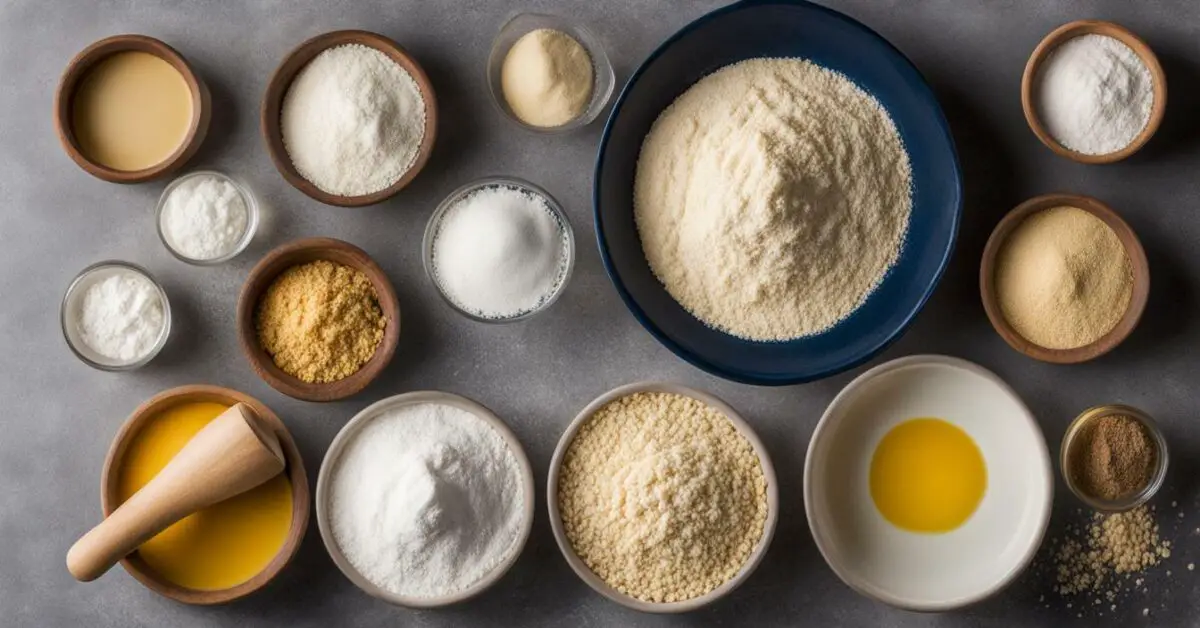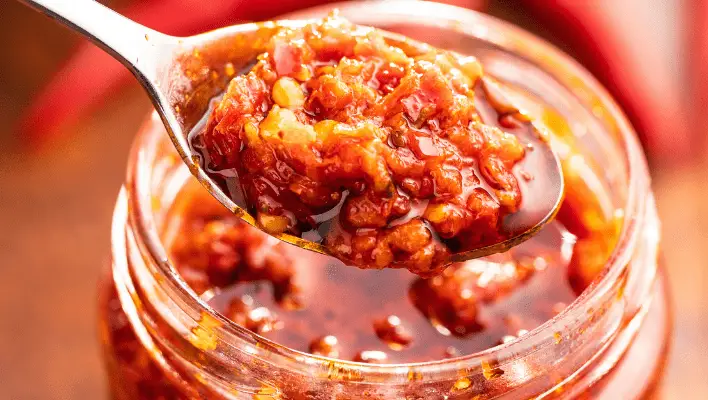
This post may contain affiliate links. Please read my disclosure for more information.
Looking for a substitute for cornstarch in your sauce? Here are the 10 best options that will enhance your cooking skills and help you achieve the desired consistency.
Key Takeaways:
- All-purpose flour can be used as a substitute for cornstarch in sauce, with a ratio of 2 tablespoons of flour for every 1 tablespoon of cornstarch.
- Arrowroot powder can be used as a substitute for cornstarch, with a 1:1 ratio.
- Potato starch is another viable substitute, with a 1:1 ratio.
- Rice flour can be used as a substitute, with a ratio of 2 tablespoons of rice flour for every 1 tablespoon of cornstarch.
- Tapioca starch can be used as a substitute, with a ratio of 2 tablespoons of tapioca starch for every 1 tablespoon of cornstarch.
These substitutes offer alternatives for thickening sauces without using cornstarch. However, it’s worth noting that some substitutes, such as glucomannan, ground flaxseed, guar gum, xanthan gum, and instant pudding mix, may have distinct flavors or textures that differ from cornstarch. It is recommended to start with a small amount and adjust as necessary.
By utilizing these substitutes, you can successfully create a sauce without cornstarch while maintaining the desired consistency and enhancing your culinary repertoire.
All-Purpose Flour: A Versatile Substitute for Cornstarch in Sauce
All-purpose flour is a versatile ingredient that can be used as a substitute for cornstarch in sauce. It is readily available in most kitchens and offers a reliable alternative for thickening sauces and gravies. To replace cornstarch with all-purpose flour, simply use two tablespoons of all-purpose flour for every one tablespoon of cornstarch.
When using all-purpose flour as a thickening agent, it’s important to create a roux first. Start by melting butter or heating oil in a saucepan over medium heat. Add the measured amount of all-purpose flour and cook, stirring constantly, for a few minutes until the mixture turns golden brown. This helps to cook off the raw flour taste and ensures a smooth consistency in your sauce.
Once the roux is ready, gradually whisk in your sauce or broth, and continue stirring until it thickens to your desired consistency. Keep in mind that the final taste of your sauce may be slightly different from when using cornstarch, as all-purpose flour can add a subtle flavor to the dish.
| Cornstarch | All-Purpose Flour |
|---|---|
| 1 tablespoon | 2 tablespoons |
| 2 tablespoons | 4 tablespoons |
| 3 tablespoons | 6 tablespoons |
So the next time you find yourself without cornstarch in your pantry, reach for all-purpose flour and confidently create a delicious and thickened sauce. Its adaptability and ease of use make it a reliable substitute for cornstarch in various sauce recipes.
Arrowroot: A Versatile Substitute for Cornstarch in Sauce
Arrowroot powder is an excellent alternative to cornstarch when thickening sauces. This gluten-free and flavorless starch is derived from the roots of the arrowroot plant, making it suitable for various dietary needs. The substitution ratio is simple: substitute one tablespoon of arrowroot powder for one tablespoon of cornstarch.
One of the advantages of using arrowroot as a thickening agent is its ability to form a clear and glossy sauce without altering the taste or color of the dish. It works well with both sweet and savory sauces, providing a smooth and silky texture. When using arrowroot, it is important to note that it thickens quickly, so it should be added towards the end of the cooking process to avoid over-thickening.
If you’re looking for a natural alternative to cornstarch, arrowroot is an excellent choice. Its neutral flavor and unique texture make it a versatile option for thickening sauces. Whether you’re making a stir-fry sauce, gravy, or dessert sauce, substituting arrowroot for cornstarch can yield delicious results.
Table: Substituting Arrowroot for Cornstarch
| Cornstarch | Arrowroot Powder |
|---|---|
| 1 tablespoon | 1 tablespoon |
Potato Starch: A Gluten-Free Substitute for Cornstarch in Sauce
If you’re looking for a gluten-free option, potato starch can be used as a substitute for cornstarch in sauce. Potato starch is derived from potatoes and is commonly used as a thickening agent in various recipes. It has a neutral taste and can provide a similar thickening effect to cornstarch.
To substitute cornstarch with potato starch, the conversion ratio is simple. Use one tablespoon of potato starch for every one tablespoon of cornstarch. This makes it easy to adapt your recipes and achieve the desired consistency in your sauces.
When using potato starch as a substitute, it’s important to note that it may result in a slightly cloudier texture compared to cornstarch. However, this doesn’t affect the taste or overall quality of your sauce. Potato starch is also suitable for use in both hot and cold sauces, making it a versatile option for various dishes.
For those with dietary restrictions or preferences, potato starch is an excellent alternative to cornstarch. It provides a gluten-free thickening option without compromising on flavor or texture. Whether you’re making a savory or sweet sauce, potato starch can help you achieve the desired consistency without using cornstarch.
| Potato Starch | Cornstarch |
|---|---|
| 1 tablespoon | 1 tablespoon |
Experiment with potato starch in your next sauce recipe and see how it compares to using cornstarch. You may find that it’s a suitable substitute that meets your dietary needs while providing the desired thickening effect.
Rice Flour
Rice flour is another gluten-free option that can be used as a substitute for cornstarch in sauce. Substitute two tablespoons of rice flour for every one tablespoon of cornstarch. Rice flour, made from finely ground rice, is a versatile thickening agent that can be used in a variety of recipes. It is especially well-suited for Asian-inspired dishes, such as stir-fries and curries.
One of the advantages of rice flour is its neutral flavor, which allows the other flavors in your dish to shine through. It also provides a smooth and silky texture to sauces without altering their taste. Keep in mind that rice flour may take a bit longer to thicken sauces compared to cornstarch, so it’s important to be patient and give it some extra time.
To use rice flour as a substitute for cornstarch in sauce, simply whisk it into a small amount of cold water to create a slurry. Add the slurry to your sauce and continue cooking until it reaches the desired consistency. It’s always a good idea to taste and adjust the seasonings as needed, as different thickeners may affect the overall flavor of your dish.
| Substitute | Ratio to Cornstarch |
|---|---|
| Rice Flour | 2 tablespoons for every 1 tablespoon of cornstarch |
Tapioca Starch
Tapioca starch is a common substitute for cornstarch in sauce. It is derived from the cassava root and has similar thickening properties to cornstarch. To use tapioca starch as a substitute, you will need to make a simple substitution ratio.
For every one tablespoon of cornstarch called for in a recipe, you can substitute two tablespoons of tapioca starch. This ratio ensures that the sauce will achieve the desired thickness without any compromise in texture or taste.
When using tapioca starch as a substitute for cornstarch, it is important to note that tapioca starch has a lower gelatinization temperature and can result in a slightly glossier finish. Additionally, tapioca starch may create a slightly chewier texture compared to cornstarch. However, in most sauces and soups, these differences are negligible.
| Cornstarch | Tapioca Starch |
|---|---|
| 1 tablespoon | 2 tablespoons |
Overall, tapioca starch is a versatile substitute for cornstarch in sauce, offering a gluten-free option for thickening your favorite recipes. With the right ratio and careful preparation, you can achieve excellent results when substituting tapioca starch for cornstarch in various sauces.
Other Potential Substitutes
In addition to the aforementioned substitutes, there are a few other options you can consider when looking for alternatives to cornstarch in sauce.
One option is glucomannan, a dietary fiber derived from the root of the konjac plant. It can be used as a substitute for cornstarch, but it’s important to note that it may impart unwanted flavors to the sauce, so it’s best to use it in sauces where its taste won’t be noticeable.
Another alternative is ground flaxseed, which can be used as a thickening agent in sauce. However, it’s worth mentioning that ground flaxseed may not provide the same texture as cornstarch, so the resulting sauce may have a slightly different consistency.
Guar gum is another substitute that can be used in sauce recipes. While it can help thicken the sauce, it may not provide the exact same texture as cornstarch, so it’s recommended to start with a small amount and adjust as necessary.
Xanthan gum is a popular thickening agent that can also be used as a substitute for cornstarch. It is highly effective in small amounts, so it’s best to start with a small quantity and add more if needed to achieve the desired consistency.
If you’re looking for a sweet alternative, instant pudding mix can be used to thicken sweet sauces and gravies. It adds both flavor and thickness, making it a great option for dessert sauces.
| Substitute | Recommended Ratio | Considerations |
|---|---|---|
| Glucomannan | N/A | May impart unwanted flavors |
| Ground Flaxseed | N/A | May not provide the same texture as cornstarch |
| Guar Gum | N/A | May not provide the same texture as cornstarch |
| Xanthan Gum | Start with a small amount | Highly effective in small quantities |
| Instant Pudding Mix | N/A | Great for thickening sweet sauces |
Conclusion
Experimenting with different substitutes for cornstarch in sauce can open up a world of new flavors and textures in your cooking. Whether you choose all-purpose flour, arrowroot, potato starch, rice flour, tapioca starch, or other alternatives, you can achieve delicious results without compromising the quality of your sauce.
Using all-purpose flour as a substitute offers a pantry staple that is widely available and easy to use, with a recommended ratio of two tablespoons of all-purpose flour for every one tablespoon of cornstarch. Arrowroot powder, on the other hand, provides a gluten-free option that can be substituted in a one-to-one ratio.
Potato starch and rice flour also make excellent substitutes, with a conversion ratio of one tablespoon per tablespoon of cornstarch for potato starch, and two tablespoons of rice flour for every one tablespoon of cornstarch. Tapioca starch, known for its thickening properties, can be used in a two-to-one ratio.
For those looking for alternative options, glucomannan, ground flaxseed, guar gum, xanthan gum, and instant pudding mix can be utilized. However, it is important to note that these alternatives may not provide the exact same texture as cornstarch, and some may impart unwanted flavors. It is recommended to start with a small amount of these substitutes and adjust as needed.
By exploring these substitutes, you can elevate your culinary creations and discover new and exciting ways to thicken your sauces without cornstarch. Whether you are following a specific dietary requirement or simply looking to experiment in the kitchen, the versatility of these alternatives allows you to create delicious sauces while accommodating your personal preferences.
FAQ
What are the best substitutes for cornstarch in sauce?
The 10 best substitutes for cornstarch in sauce are all-purpose flour, arrowroot, potato starch, rice flour, tapioca starch, glucomannan, ground flaxseed, guar gum, xanthan gum, and instant pudding mix.
How much all-purpose flour should I use as a substitute for cornstarch in sauce?
Use two tablespoons of all-purpose flour for every one tablespoon of cornstarch.
Can I use arrowroot as a substitute for cornstarch in sauce?
Yes, you can substitute one tablespoon of arrowroot powder for one tablespoon of cornstarch.
How do I use potato starch as a substitute for cornstarch in sauce?
Use one tablespoon of potato starch for one tablespoon of cornstarch.
Can rice flour be used as a substitute for cornstarch in sauce?
Yes, you can use two tablespoons of rice flour for every one tablespoon of cornstarch.
How do I substitute tapioca starch for cornstarch in sauce?
Use two tablespoons of tapioca starch for every one tablespoon of cornstarch.
What other potential substitutes are there for cornstarch in sauce?
Other potential substitutes include glucomannan, ground flaxseed, guar gum, xanthan gum, and instant pudding mix. However, these substitutes may not provide the same texture as cornstarch, and some may impart unwanted flavors.


